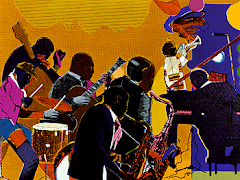


A Review By Sojourner Ahebee
This past Tuesday I went to The National Constitution Center to see the Ancient Rome and America exhibition. What an experience! I never knew Ancient Rome and Early America had so much in common. It’s amazing how closely America used the Roman Empire as a model for her own country and created a new republic where the majority of the people’s interests were represented.
In the beginning of the exhibition you are greeted with the myth of Romulus and Remus. No one knows for sure if these supposed twin brothers actually founded Ancient Rome, but it’s always fun to wonder. As I was going through the exhibition with my cousin, (who had actually just came back from Italy), she pointed out that the myths about the conditions of the war for soldiers during the American Revolution were way more believable that the Roman myths. While we’re still on the subject of the American Revolution, George Washington, who led this war, was mentioned many times. I thought the bust of himself ,sculpted by William Ruse, was very amusing. I
In the beginning of the exhibition you are greeted with the myth of Romulus and Remus. No one knows for sure if these supposed twin brothers actually founded Ancient Rome, but it’s always fun to wonder. As I was going through the exhibition with my cousin, (who had actually just came back from Italy), she pointed out that the myths about the conditions of the war for soldiers during the American Revolution were way more believable that the Roman myths. While we’re still on the subject of the American Revolution, George Washington, who led this war, was mentioned many times. I thought the bust of himself ,sculpted by William Ruse, was very amusing. I
mean come on? He was wearing a toga!
I really found the whole slavery comparison between the US and Ancient Rome very interesting. Both Ancient Rome and early America had slaves at one point in time. The exhibition highlighted the slave collars that were used to identify slaves who had tried to escape. It brought chills to the backs of both my cousin and me, who got to see first-hand the actual materials that were used to dehumanize people in both societies.
I really found the whole slavery comparison between the US and Ancient Rome very interesting. Both Ancient Rome and early America had slaves at one point in time. The exhibition highlighted the slave collars that were used to identify slaves who had tried to escape. It brought chills to the backs of both my cousin and me, who got to see first-hand the actual materials that were used to dehumanize people in both societies.
The American slave collar presented in this exhibition belonged to a man named Ben, who had been enslaved in the South. He had tried to run away from the plantation where he worked, but he did not make it. He was made to wear this very slave collar until he was sold to another slave owner, who had promised Ben on a particular date he would be set free. The day he was suppose to be set free, he was kidnapped and sold back into the vicious cycle of slavery and his exact whereabouts were never known. Great injustices similar to this one happened almost everyday in colonial America. It enrages me that this was the case, but I’m pleased that The Constitution Center chose to present these uncomfortable realities. On the other hand, white Roman slaves had a bit of a greater advantage than slaves in America. They were able to eventually excel in society with hard work and even buy their freedom.
The book Notes on the State of Virginia, written by Thomas Jefferson, was the first book to reference slavery in Ancient Rome and used to justify slavery in America. The fallout from slavery and the horrific problems it created are still with us today.
While the slavery aspect of the exhibition was poignant, the story of Pompeii was heart-wrenching The cities of Pompeii and Herculaneum sat on Mount Vesuvius, an active volcano. In 79 CE, this volcano spit rock and other debris that buried people who were unable to escape the area consumed by the volcanic activity. People were instantly killed by this volcanic debris that reached temperatures as high as 250 C and they were covered by twelve different layers of soil. The Ancient Roman and America exhibition actually shows a cast made from the imprint of a man who was found huddled near the wall of a gymnasium entrance in Pompeii . Pompeii was only rediscovered by accident when in 1738, workmen were digging for the foundations for a summer palace for the King of Naples, Charles of Bourbon. In 1748, the Spanish military engineer Rocque Joaquin de Alcubierre organized an intentional excavation.
Through this journey of comparison between America and Ancient Rome, I learned many new things about my own country as well as Ancient Rome. I don’t want to tell you everything, because you need to experience it for yourself. This exhibition leaves August 1, 2010. So hurry! You do not want to miss it. Below is a link to The Constitution Center’s website for Ancient Rome and America. Remaining dates and times are listed. Enjoy.
http://www.constitutioncenter.org/rome/
The book Notes on the State of Virginia, written by Thomas Jefferson, was the first book to reference slavery in Ancient Rome and used to justify slavery in America. The fallout from slavery and the horrific problems it created are still with us today.
While the slavery aspect of the exhibition was poignant, the story of Pompeii was heart-wrenching The cities of Pompeii and Herculaneum sat on Mount Vesuvius, an active volcano. In 79 CE, this volcano spit rock and other debris that buried people who were unable to escape the area consumed by the volcanic activity. People were instantly killed by this volcanic debris that reached temperatures as high as 250 C and they were covered by twelve different layers of soil. The Ancient Roman and America exhibition actually shows a cast made from the imprint of a man who was found huddled near the wall of a gymnasium entrance in Pompeii . Pompeii was only rediscovered by accident when in 1738, workmen were digging for the foundations for a summer palace for the King of Naples, Charles of Bourbon. In 1748, the Spanish military engineer Rocque Joaquin de Alcubierre organized an intentional excavation.
Through this journey of comparison between America and Ancient Rome, I learned many new things about my own country as well as Ancient Rome. I don’t want to tell you everything, because you need to experience it for yourself. This exhibition leaves August 1, 2010. So hurry! You do not want to miss it. Below is a link to The Constitution Center’s website for Ancient Rome and America. Remaining dates and times are listed. Enjoy.
http://www.constitutioncenter.org/rome/


























